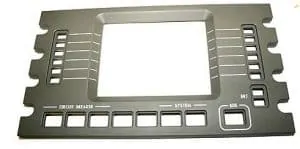History of Aerospace Backlit Panels
Over the years, the cockpit of an airliner or military jet have grown increasingly complex as modern aerospace technology has developed.
It is certainly a lot different from the bare bones instrument panel that took Charles Lindbergh across the Atlantic in 1927.
It is hard to imagine, but The Spirit of St. Louis had few gauges and no lighting. Of course, these days one element that is in almost every aircraft on earth is the backlit panel. The idea of trying to read a critical gauge or push a button in the dark is not only unimaginable but also extremely dangerous.
Backlit Panels: Where it all Began
Attempting to make panels readable in the dark has become an exacting science, but it is not a new technology. In 1933, Grimes Manufacturing (now a part of the Honeywell Corporation) began producing lighting for aircrafts, both internally and externally.
Early illumination was rudimentary at best. Some instrument panels were lit via post lights, which were small masked bulbs that were threaded through instrument mounting holes. Other methods included small spot lights that were above the pilot’s head and pointed toward the controls.
Some ingenious tricks were developed to illuminate instrument controls and other necessary equipment in the cockpit included things like done a combination of small flood lighting and florescent paint.
 The first real backlit panels came about a few years later, and many of these designs remained the standard for decades. The panel lamps and indicators were fabricated by a company called Dialco, now called Dialight. These panels were very sophisticated mechanically and remain in use in both military and civilian aircraft to this day.
The first real backlit panels came about a few years later, and many of these designs remained the standard for decades. The panel lamps and indicators were fabricated by a company called Dialco, now called Dialight. These panels were very sophisticated mechanically and remain in use in both military and civilian aircraft to this day.
Color Lighting
Initial night instrument panel lighting was mainly in red. Red lighting has the lowest impact on a person’s night vision. As technology advanced, red lighting eventually moved to “aviation blue-white” which allow all instrument colors to accurately be seen. This also allowed the color red to be used only for warning of serious issues within the cockpit area.
With the introduction of colored lights, there has been a standardization of the meaning of each color. Red remains the notice of serious danger. Yellow is a warning light for pilots to take notice. Green is for normal operations. Blue or white for informational messages.
Leap Forward with LED Technology
The entire industry took a giant leap forward with the introduction of marketable Light Emitting Diode (LED) bulb technology in the 1960’s. This was a big step in aerospace panels because unlike incandescent bulbs, LEDs don’t contain filaments that can burn out.
LEDs are the perfect choice for backlighting of aerospace panels for a number of reasons including: longer lifespan, small size, color choices, and brightness
Prime Products
Since most of the technology remains the same on today’s aerospace panels, the real key is to find the right manufacturer. At Prime Products, we think we are the best custom fabricators of illuminated components in the business.
We produce toning and light control panels, keypads, knobs, and buttons for all aerospace applications. Prime Products knows how critical performance is when it comes to aerospace backlit panels. That is why we perform photometer measurements on brightness (foot-lamberts), transmission, contrast ratios, and chromaticity (x, y).
All Prime Product components are 100% inspected for light leaks in the non-illuminated areas. In addition, we can comply with MIL-P-7788, AS7788, AS25050 and other military and industry standards.
To learn more about aerospace backlit panels and how Prime Products can help you, please visit our website or contact us directly.






